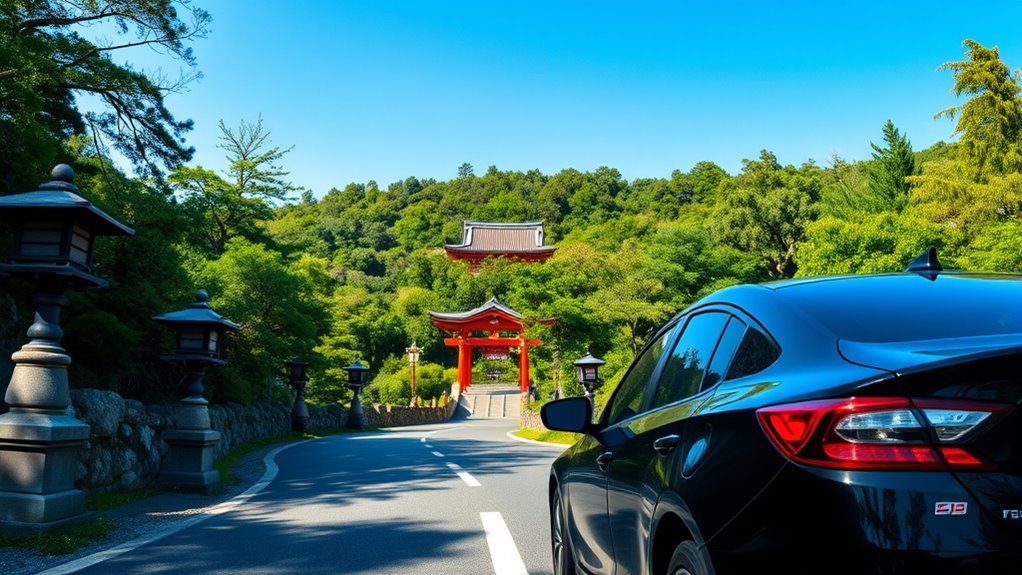Driving the Shikoku 88 Temple Pilgrimage lets you explore sacred sites at your own pace while enjoying local culture. Plan your route carefully, prioritize key temples, and prepare your vehicle and supplies in advance. Respect local customs, follow proper etiquette, and engage with communities along the way. Managing your schedule helps avoid fatigue, and staying flexible enhances your experience. To navigate these sacred grounds smoothly and meaningfully, keep exploring for helpful tips and insights.
Key Takeaways
- Traveling by car offers flexibility to visit all 88 temples at your own pace, including remote and lesser-known sites.
- Plan your route in advance using GPS and local maps, ensuring efficient visits and avoiding unnecessary detours.
- Respect cultural customs at each temple, such as purification rituals and proper conduct, to enhance spiritual experience.
- Allocate time for rest, local interactions, and exploring nearby sights to enrich the pilgrimage journey.
- Ensure your vehicle is well-maintained and equipped with essentials like water, snacks, and navigation tools for a smooth trip.
Planning Your Road Trip: Essential Tips for the Shikoku Pilgrimage
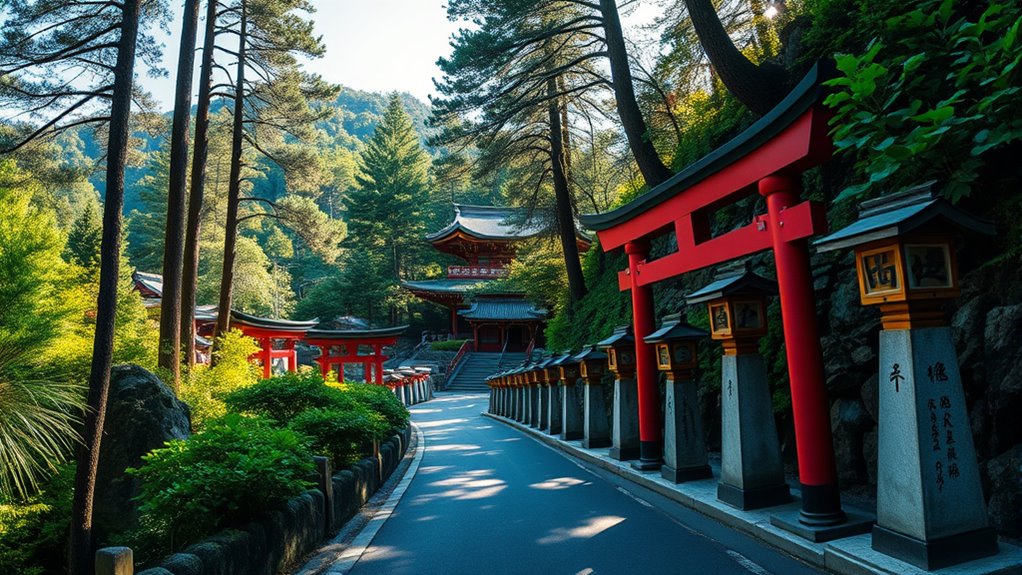
Planning your road trip for the Shikoku 88 Temple Pilgrimage requires careful preparation to guarantee a smooth and meaningful experience. Start by researching the temples and creating a flexible itinerary that balances sightseeing and rest. Make sure your vehicle is in good condition, with all necessary documents, like insurance and permits. Consider renting a car with GPS or a reliable navigation app to help you stay on track. Pack essentials such as comfortable clothing, snacks, water, and a first aid kit. Familiarize yourself with local driving laws and parking options around the temples. Planning ahead assures you won’t miss important sites and can adapt to unexpected delays. Additionally, understanding vehicle maintenance and ensuring your car’s performance can prevent breakdowns during your journey. Being aware of regional resources can also help you find nearby services if needed. Staying vigilant about small mistakes that could impact your trip’s success can save you from unnecessary setbacks. Conducting a pre-trip vehicle inspection can identify potential issues before they become problems on the road. With thorough preparation, your pilgrimage becomes a rewarding journey of cultural discovery and spiritual reflection.
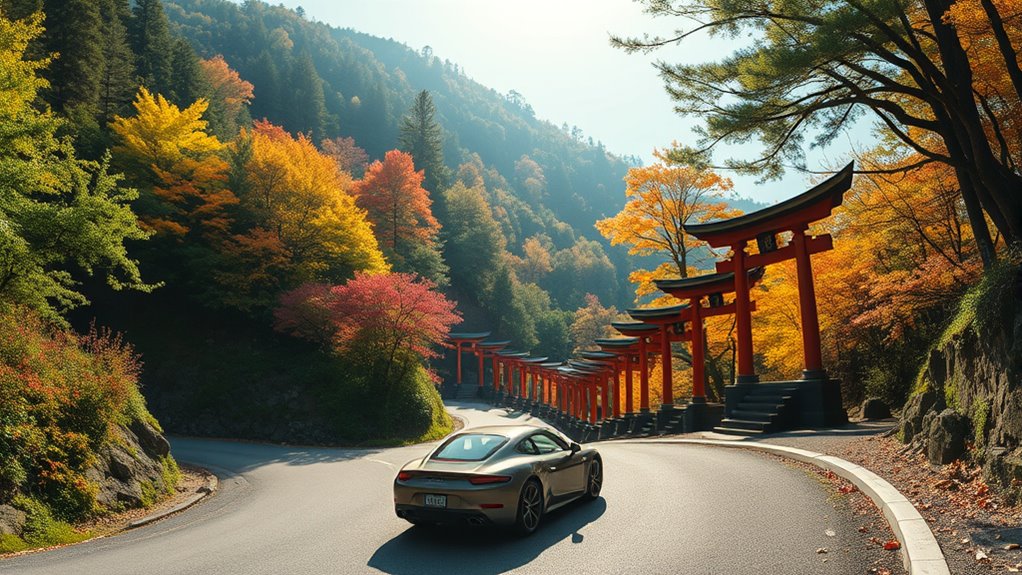
To successfully navigate the Shikoku route, you need solid map and transportation strategies. You’ll want to understand your options, from detailed maps to local transit choices. Clear navigation tips will keep your journey smooth and focused. Incorporating advanced tuning software can also help optimize your vehicle’s performance for longer trips, ensuring reliability and efficiency throughout your pilgrimage. Additionally, considering the role of contrast ratio in vehicle displays can improve visibility of navigational aids under different lighting conditions. Being aware of privacy and cookie usage on digital mapping services can help you manage your online privacy while planning your route effectively. Moreover, selecting reliable navigation tools can significantly reduce the chances of getting lost in unfamiliar areas.
Route Planning Strategies
Traveling the Shikoku 88 Temple route requires careful map and transportation planning to guarantee a smooth pilgrimage. To make your journey seamless, consider these strategies:
- Plot your route in advance to avoid unnecessary detours and ensure you visit all temples efficiently.
- Identify key landmarks and rest stops along the way to stay energized and focused.
- Schedule your driving hours wisely to prevent fatigue, especially during long stretches.
- Use reliable navigation apps that update in real-time, helping you adapt to traffic or road closures.
- Incorporate well-being tips to maintain comfort and reduce stress during your journey, ensuring a more enjoyable experience.
Transportation Options Overview
Traveling the Shikoku 88 Temple route offers a variety of transportation options to suit different preferences and schedules. Many pilgrims opt for driving, as it provides flexibility to explore remote temples and stop at local sights. Rental cars are available if you don’t bring your own, giving you the convenience of a personal vehicle. Public transportation, such as trains and buses, also covers major routes and nearby towns, making it a cost-effective choice. Some travelers combine options, using trains to reach key areas and renting bikes or scooters for local travel. Taxis are available for quick or flexible transfers, especially when navigating difficult terrain or tight schedules. Whichever mode you choose, ensure it fits your pace and comfort level for a smooth pilgrimage experience.
Navigating With Maps
Using maps effectively can make your Shikoku 88 Temple pilgrimage smoother and more enjoyable. First, always carry a detailed local map or a reliable navigation app to avoid getting lost in unfamiliar areas. Second, familiarize yourself with key routes and landmarks before setting out, so you can confidently navigate even without constant GPS signals. Third, pay attention to signs and markers dedicated to pilgrims, which often point toward temples or specific routes. Fourth, keep an eye on traffic updates and road closures, especially during peak seasons or festivals, to adjust your plans on the fly. Fifth, understanding market research can help you find the best routes and accommodations based on other pilgrims’ experiences. Sixth, using automotive navigation tools like GPS apps tailored for travelers can enhance your route planning and real-time guidance. With these strategies, you’ll feel more in control and less stressed, allowing you to focus on the spiritual journey ahead. Proper navigation transforms your pilgrimage into a memorable adventure.
Cultural Etiquette and Respect at Sacred Sites
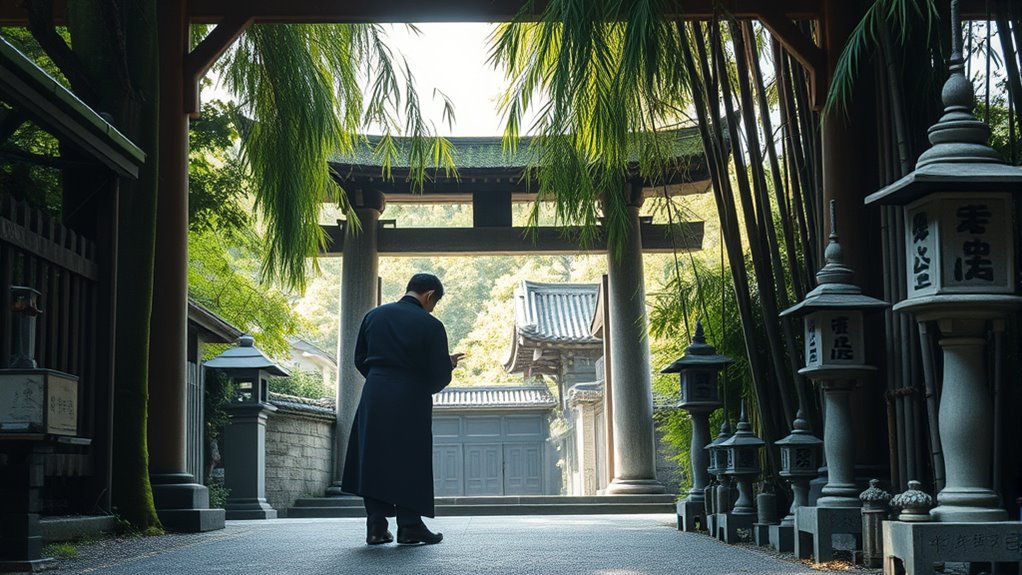
When visiting sacred sites, you’ll want to follow proper bowing techniques and show respect through your gestures. Observing ritual purification customs helps honor local traditions and shows your sincerity. Remember to behave respectfully, keeping noise to a minimum and being mindful of the sacred atmosphere. Incorporating cultural etiquette helps demonstrate your understanding and appreciation of the spiritual significance of the sites. Additionally, understanding vetted conversion kits can enhance your experience if you choose to explore biking options for your journey. Being aware of security vulnerabilities associated with new technologies can also be useful if you plan to use digital payment methods during your visit. Familiarizing yourself with trusted security practices ensures your digital transactions remain safe and secure.
Proper Bowing Techniques
Proper bowing techniques are essential to show respect at sacred sites during your pilgrimage. When approaching a temple, follow these steps to demonstrate reverence:
- Stand straight with your hands pressed together in a prayer-like gesture, known as gassho.
- Bow deeply from the waist, approximately 45 degrees, showing humility and respect.
- Hold the bow for a moment, acknowledging the sacred space.
- Rise slowly and silently, maintaining a respectful demeanor.
- Practicing cultural etiquette such as proper bowing not only honors the traditions but also fosters a genuine spiritual connection.
- Remember that spiritual significance is conveyed through your respectful gestures, enhancing your overall experience.
- Incorporating such respectful gestures aligns with respect for traditions, emphasizing the importance of cultural sensitivity during your visit.
- Developing a mindful attitude while performing these gestures can further deepen your creative awareness and connection to the sacred environment.
Ritual Purification Customs
As you approach each sacred site during your pilgrimage, engaging in ritual purification customs demonstrates your respect and mindfulness. Before entering the main hall, you’ll find a purification fountain, called a temizuya. Use the ladle to rinse your left hand, then your right, ensuring cleanliness. Next, pour water into your left hand to rinse your mouth, but do not swallow the water—spit it beside the basin. Finally, rinse the ladle and let it rest upside down. These actions symbolize cleansing both physically and spiritually. Performing these steps quietly and respectfully, showing your awareness of the sacred space, helps you connect with the spiritual atmosphere. Ritual purification customs like this help you connect with the spiritual atmosphere and honor the traditions of the temple. Remember, sincerity matters more than perfection. Necessary cookies enable basic functionalities like secure log-in, supporting the overall user experience during your visit. Incorporating mindfulness during this process can deepen your spiritual connection and enhance your overall experience. Additionally, understanding the cultural etiquette associated with these rituals can further enrich your respectful participation.
Respectful Behavior Expectations
Showing respect at sacred sites is essential to honoring the traditions and spiritual significance of each temple. As you visit, remember these key behaviors:
- Maintain a quiet, reverent demeanor to honor others’ prayer and reflection.
- Follow signs and guidelines, such as removing shoes before entering sacred areas.
- Refrain from taking photos where prohibited, respecting the privacy of worshippers.
- Offer a sincere bow when entering and leaving, showing humility and respect.
- Be mindful of cultural etiquette to ensure your conduct aligns with local customs and preserves the sanctity of the sites.
- Staying informed about regulations and customs helps deepen your understanding and appreciation of the cultural context.
- Practicing authenticity in your behavior demonstrates genuine respect for the spiritual environment you are entering.
Your respectful conduct ensures the sanctity of the temples remains intact and demonstrates your appreciation for local customs. By embracing these behaviors, you honor the spiritual essence of each site, fostering a meaningful and harmonious pilgrimage experience.
Key Temples to Prioritize on Your Journey
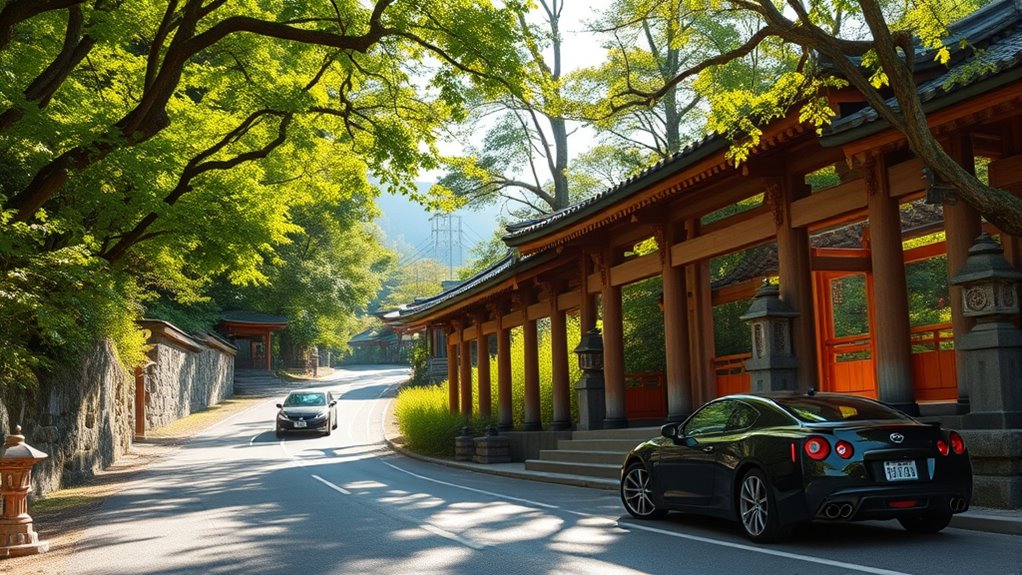
Which temples should you focus on to make the most of your Shikoku pilgrimage? Start with Kongōfuku-ji (temple 1), the traditional starting point, and then visit Zentsū-ji (temple 75), known for its impressive statue and tranquil grounds. Don’t miss the iconic 88th temple, Henraku-ji, which marks the end of your journey and offers a sense of accomplishment. Other key stops include Ryozen-ji (temple 1), the official beginning, and Dōryū-ji (temple 64), famous for its beautiful gardens. Prioritizing these major temples helps you experience the spiritual highlights and cultural significance of the pilgrimage. While all temples hold value, focusing on these ensures you connect deeply with the tradition and history of Shikoku’s sacred trail. Understanding the importance of cultural significance] enhances your appreciation of each site and enriches your overall experience.
Practical Considerations: Accommodation, Food, and Supplies
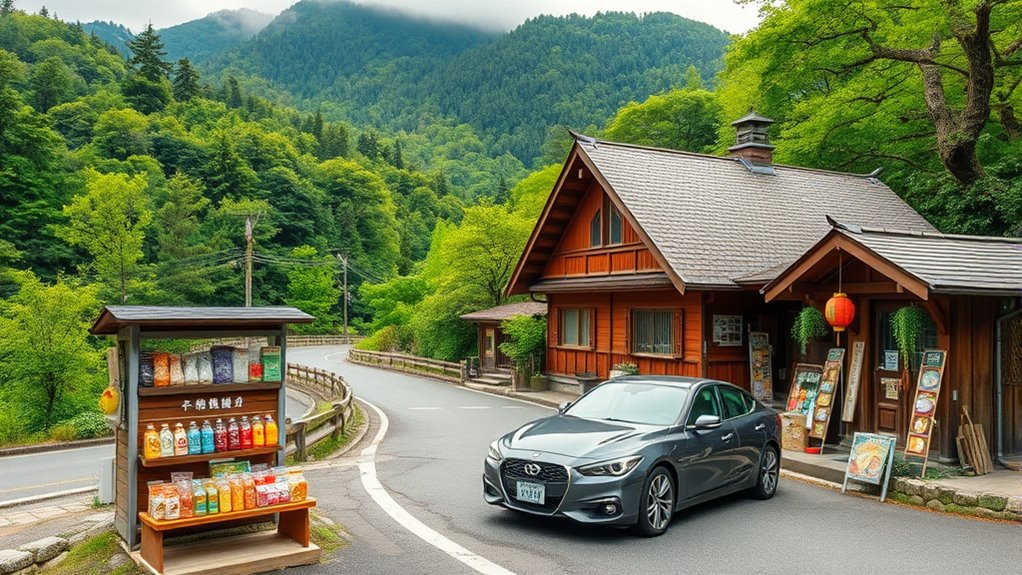
Planning for accommodation, food, and supplies is essential to guarantee a smooth and meaningful pilgrimage. Without proper planning, you might face unnecessary stress or missed experiences. Consider these key points:
- Reserve accommodations early, especially in rural areas, to ensure a comfortable stay.
- Pack enough snacks and water to stay energized during long temple visits.
- Bring basic supplies like a first aid kit, comfortable walking shoes, and weather-appropriate clothing.
- Familiarize yourself with local dining options, including convenience stores and small eateries, to enjoy authentic meals without hassle.
- Understanding spiritual guidance and the significance of the journey can enhance your experience and help you prepare mentally for the pilgrimage. Additionally, being aware of digital literacy can assist in navigating modern amenities and communication during your trip, which is especially helpful when managing local regulations and safety protocols. Being informed about emergency procedures can further ensure your safety in unfamiliar surroundings.
Managing Time and Daily Itinerary Strategies
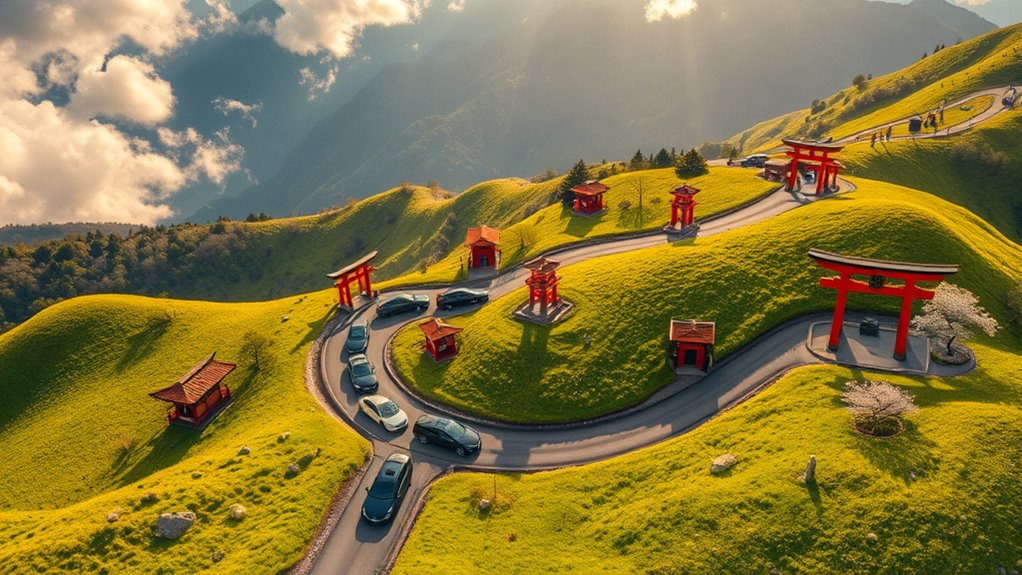
To make the most of your Shikoku 88 Temple Pilgrimage, managing your time effectively is essential. Plan your daily schedule with flexibility, allowing extra time for unexpected delays or sightseeing. Prioritize temples based on their location, opening hours, and your personal interests. Use a detailed itinerary that maps out driving routes and estimated travel times, ensuring you don’t rush or linger too long at each site. Incorporate rest periods to prevent fatigue, especially if you’re driving long distances. Keep track of your progress with a checklist or app, so you stay on schedule. Staying organized helps you enjoy the spiritual journey without feeling overwhelmed, making each day meaningful and balanced. Proper time management turns a challenging schedule into a rewarding experience.
Engaging With Local Communities and Traditions
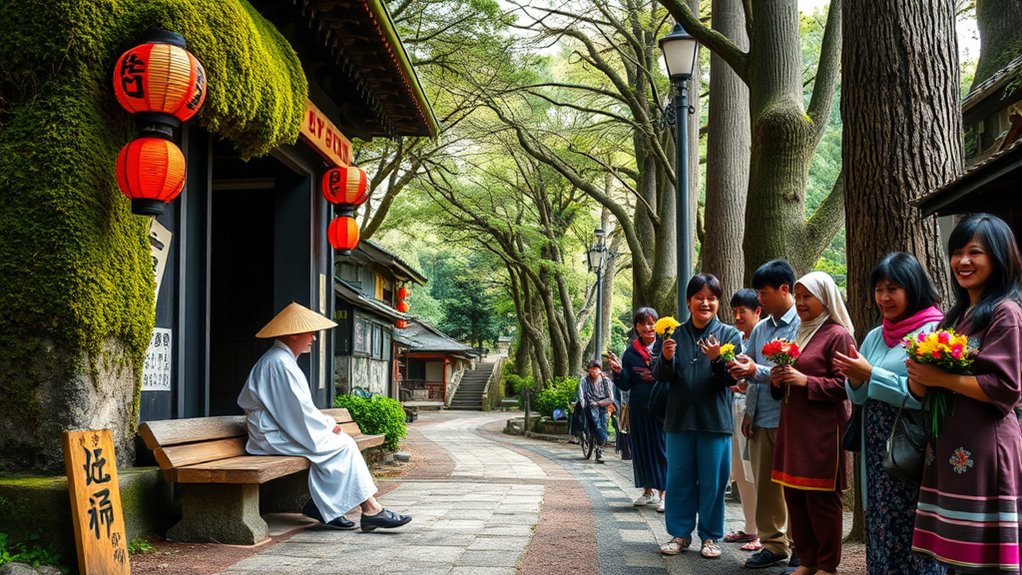
After organizing your daily schedule and routes, engaging with the local communities along the pilgrimage route enriches your experience. You’ll have the opportunity to:
- Share a warm smile with locals, feeling their genuine hospitality and kindness.
- Participate in traditional events, such as festivals or ceremonies, deepening your cultural understanding.
- Taste authentic regional dishes, connecting through shared meals that tell stories of local heritage.
- Hear personal stories from residents, gaining insights into the area’s history and spiritual significance.
These interactions create meaningful moments that transcend sightseeing. Embracing local traditions and connecting with residents turn your pilgrimage into a heartfelt journey, fostering a sense of unity and respect that stays with you long after the trip ends.
Safety and Vehicle Preparation for the Pilgrimage
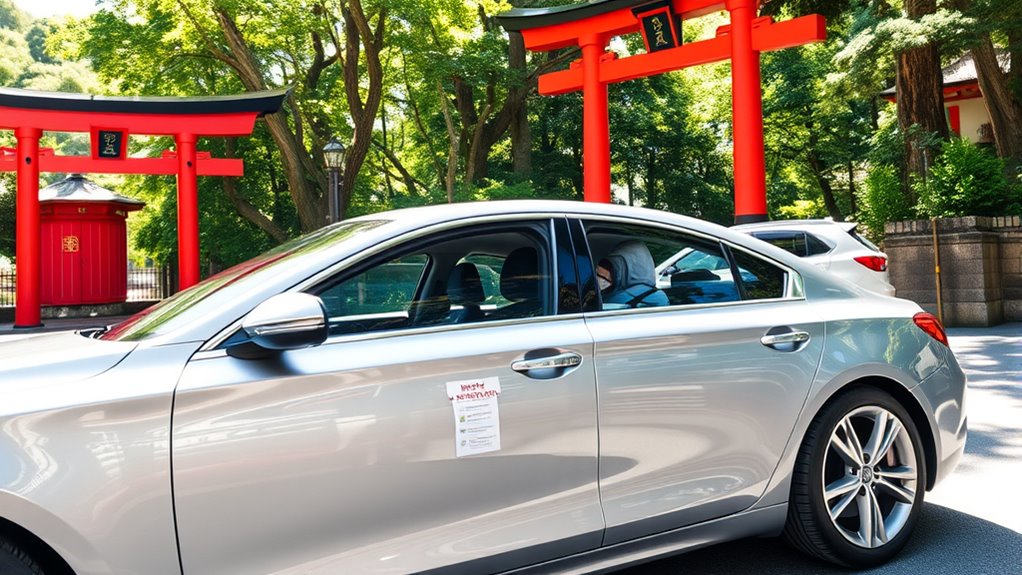
Ensuring your vehicle is well-prepared and safe is essential for a smooth and enjoyable Shikoku 88 Temple Pilgrimage. Before setting out, check your tires for proper inflation and tread wear, and ensure brakes are responsive. Confirm that all fluid levels—oil, coolant, brake fluid—are topped up. Pack an emergency kit with essentials like a first-aid kit, flashlight, and basic tools. Make sure your GPS or navigation system works reliably, and carry physical maps as backups. Plan your route carefully to avoid unfamiliar or hazardous roads. Keep your phone charged and inform someone about your itinerary. Regularly take breaks to avoid fatigue, and stay alert for local driving customs and road signs. Proper preparation keeps you safe and focused on the spiritual journey ahead.
Reflecting on Your Spiritual and Cultural Experience
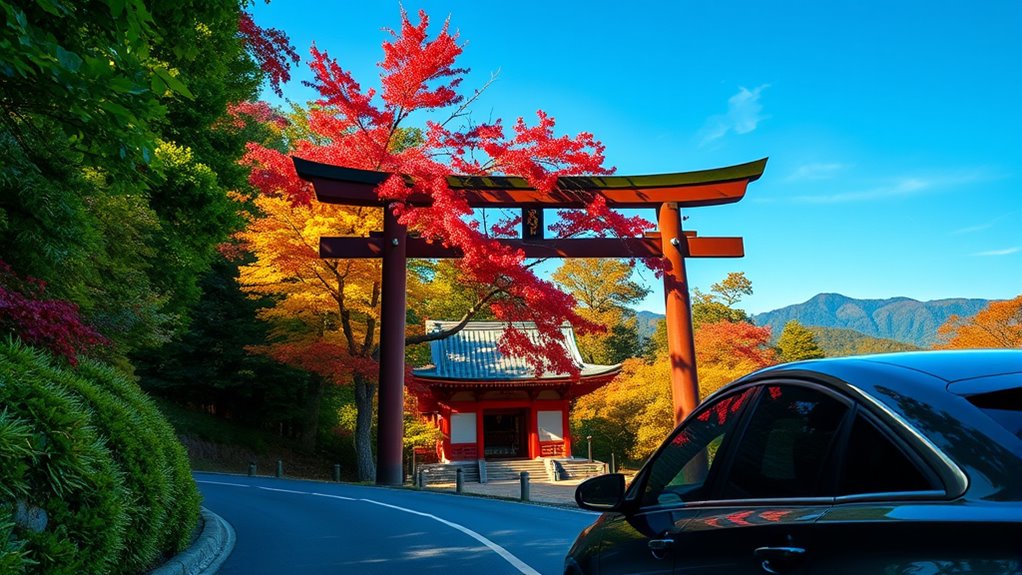
As you complete each visit to the temples, take time to reflect on the spiritual and cultural significance of your journey. This is your moment to connect deeply with the traditions and history that have shaped this pilgrimage. Consider how:
- You’ve engaged with centuries-old practices, feeling a sense of continuity.
- The serene surroundings brought clarity and peace to your mind.
- The stories of monks and pilgrims inspired your own spiritual growth.
- The shared reverence fostered a profound appreciation for Japanese culture.
Let these reflections deepen your understanding and gratitude. Recognize how this experience has touched your soul and broadened your perspective. Your journey isn’t just about visiting temples — it’s about embracing a rich spiritual heritage.
Frequently Asked Questions
Are There Guided Tours Available for the Shikoku Pilgrimage by Car?
You’re curious if guided tours exist for the Shikoku pilgrimage by car. Yes, many tour operators offer guided experiences tailored to travelers who want to explore the temples with expert guidance. These tours often include transportation, detailed itineraries, and cultural insights. Booking a guided tour can enhance your journey, making it more meaningful and manageable, especially if you’re unfamiliar with the region or prefer a structured experience.
Can I Customize the Order of Temples I Visit During the Pilgrimage?
You can definitely customize the order of temples you visit during your pilgrimage. Since you’re driving, you have the flexibility to plan your route based on your preferences, time, and energy levels. You’re not bound to follow a strict sequence, so feel free to prioritize certain temples or explore areas that interest you most. Just make sure to map out your route in advance for a smooth and enjoyable journey.
What Are the Costs Associated With Completing the Pilgrimage by Car?
Imagine you’re on a quest in a world before GPS—costs for completing the pilgrimage by car vary. You’ll spend on fuel, which depends on your route and vehicle efficiency, and tolls across highways. Don’t forget parking fees at temples and potential car rental costs if you don’t own a vehicle. Budget wisely, as these expenses add up, but the spiritual rewards are priceless.
How Do I Handle Language Barriers When Communicating at Temples?
When you face language barriers at temples, it’s helpful to prepare ahead. Bring a translation app or phrasebook to assist with basic communication. Learning a few Japanese greetings and polite expressions can make interactions smoother. Be patient, smile, and use gestures if needed. Many temple staff are accustomed to international visitors and may understand simple English or use visual cues, making your visit more comfortable and respectful.
Is It Possible to Combine the Pilgrimage With Other Sightseeing Activities?
You can absolutely combine your pilgrimage with other sightseeing adventures—imagine turning a spiritual journey into an epic exploration of Shikoku’s breathtaking landscapes! Visit charming towns, scenic coastlines, and vibrant markets along the way. Many travelers find that blending cultural sites with natural wonders makes the experience unforgettable. Just plan your route wisely, so you can enjoy both the sacred temples and the region’s diverse attractions without feeling rushed.
Conclusion
Completing the Shikoku 88 Temple Pilgrimage by car offers a profound connection to Japan’s spiritual heritage. Did you know over 200,000 pilgrims undertake this journey each year? Embrace the cultural richness, respect sacred sites, and savor local traditions. With careful planning, your adventure becomes not just a trip, but a meaningful experience that deepens your understanding of Japan’s spiritual landscape and its enduring traditions.
